Are there any other fish that look like Alligator gar? Yes. There are. Although not as large as Alligator gar, there are six other gar species that look like the Alligator gar. This article is about types Of Gar Fish.
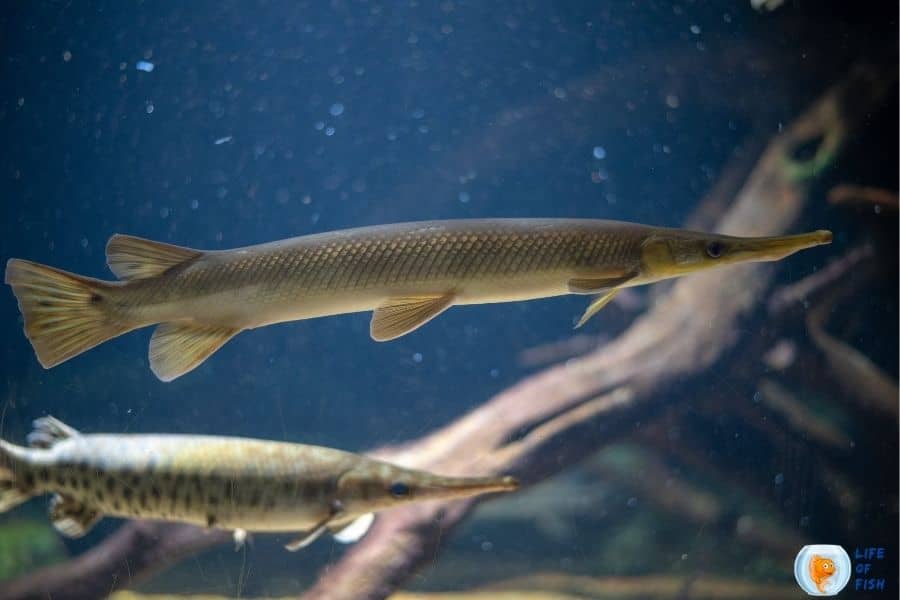
What are gar fish?
Jump To
Gars, also known as “living fossils,” are a group of freshwater fish belonging to the Lepisosteidae family.
Gars have been the only surviving members of the Ginglymodi clade since the Triassic period, making them one of the oldest living groups of fish.
Their history goes back to the Dinosaur Age, over 240 million years ago.
Gars are famous for their long, slender body and needle-like teeth. They can grow up 6ft (and more) in length and can weigh up to 300 pounds.
This fish live around 30-50 years. They are nocturnal hunters feeding on crustaceans, frogs, fish, and other smaller gars.
These fish can breathe air. They accomplish this by their swim bladder, which has evolved to become a primitive lung.
This ability allows them to survive in low oxygenated water, like the muddy bottoms of swamps and lakes, under ice, or in water with low dissolved oxygen.
Also, they also produce toxic gar eggs. They can cause vomiting or even death if eaten. On the other hand, gar meat is famous in USA as a delicacy.
Generally, they are solitary fish, but sometimes they like to live in large groups.
There are seven extant gar species belonging to two genera that inhabit Central America, North America, and Cuba in the Caribbean.
The extinct members of the gar family used to live across the world (according to fossil records). However, the living gars’ distribution is limited to the USA waters.
Letts find out different types of gar fish in here.
Alligator Gar
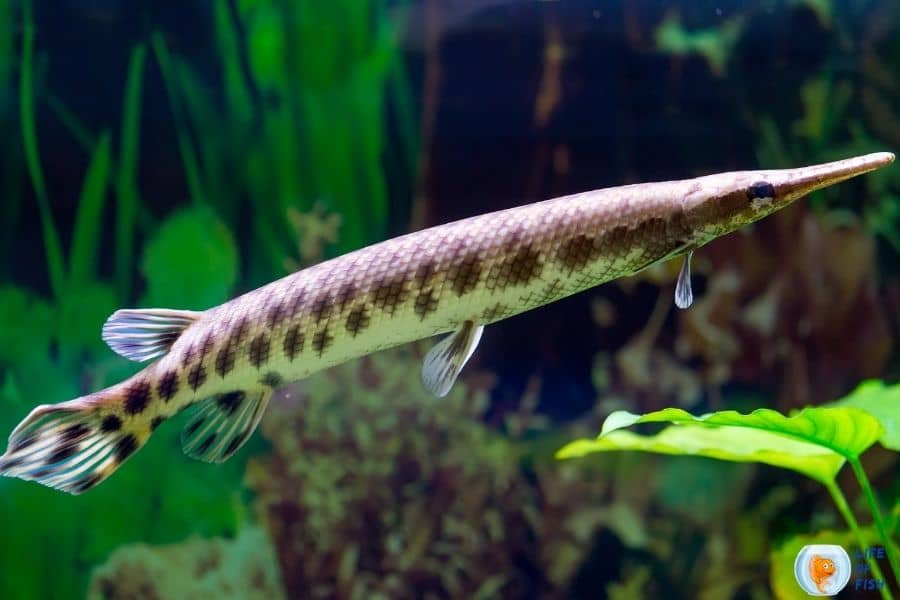
Alligator gar is the largest species of gars, which can grow up to 10ft long and weigh over 350lbs.
Their habitat is mainly in the USA’s Gulf Coastal states, including Texas, Louisiana, Mississippi, and Alabama.
Alligator gar is prized among anglers for its massive size and fighting prowess, but the species is considered endangered by many environmentalists.
Due to their unique alligator-like appearance, these fish are also popular in public aquaria.
Appearance
As the name suggests, Alligator gars have an appearance that resembles Alligators.
They have an alligator-like head, a torpedo-shaped body, and short dorsal and anal fins that are positioned toward the back of their bodies.
Their scales are large, shiny, and diamond-shaped. Their body color is olive-brown with yellowish shades, same as an alligator’s skin color.
Gars are famously known for their very sharp, long, and pointy teeth; two rows of large, jagged teeth are located on the upper jaw.
Read More : Alligator Gar Size | 9 Interesting Facts You Must Know |
Habitats
Alligator gars can survive in a wide variety of aquatic habitats, but they prefer still waters such as swamps, large rivers, and reservoirs.
They are primarily found in freshwater, but they can move between different habitats using brackish water estuaries, coastal waters, and other nearshore marine habitats.
Read More : Where Do Alligator Gars Live? | 9 Doubts You Should Clarify |
What they eat
Alligator gars are ambush predators, which means they feed only when prey swims directly in front of them.
They have a good sense of smell, thanks to the “four on each side” nostrils located near the end of their snout.
They are mainly piscivores but also eat birds, small mammals, crayfish, and crustaceans.
Alligator gars are known for producing sounds. However, the mechanism behind it remains a mystery to scientists.
The sounds are created by gar muscles that contract against their swim bladder, rubbing it against the swim bladder and the bones surrounding it.
This mechanism is similar to that in toads, which rub their vocal sac against their lungs while producing sounds.
Read More : What does Alligator Gar Eat? | 14 Crazy Facts About Alligator Gars |
Cuban Gar
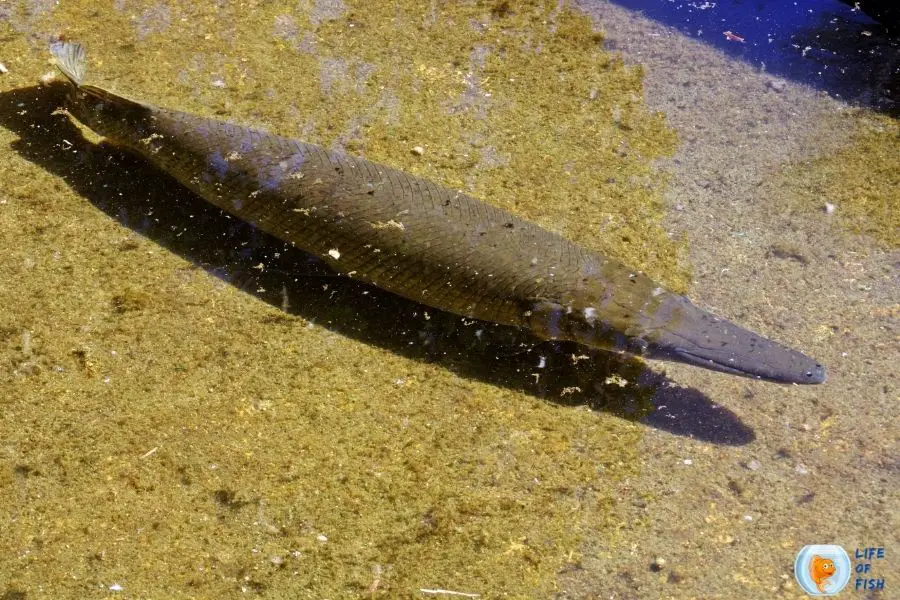
Cuban Gar is the second largest species of Gar that can reach about 6.6 feet in length.
They are found in freshwater habitats in Western Cuba, the Isla de la Juventud, hence the name Cuban Gar.
The population of these species has been declined to a greater extent due to overfishing and habitat loss. Therefore, these fish are now listed as critically endangered in the IUCN Red List.
Appearance
Cuban gars are easily confused with Alligator Gar because of their similar appearance and size. However, Cuban gars have a less pronounced snout than an Alligator gar.
They also have a torpedo-shaped body and armed scales like other gar species. The dorsal fin and the anal fin are positioned near the tail like its relative, Alligator gar.
However, the Cuban Gar has a less colorful body than the Alligator gar. The color of Cuban Gar is grey, which is common in most aquatic creatures.
Habitats
These fish often inhabit tropical freshwater habitats such as rivers, lakes, and swamps. Cuban gars also live in brackish water estuaries due to their rich stocks of fish and shrimps.
What they eat
Since this is a gar, it feeds on fish, birds, and shrimps. They are ambush predators that wait patiently in the shallow waters until a fish swims directly in front of them.
They use their long and pointy teeth to catch prey, as they do with every gar species.
Florida Gar
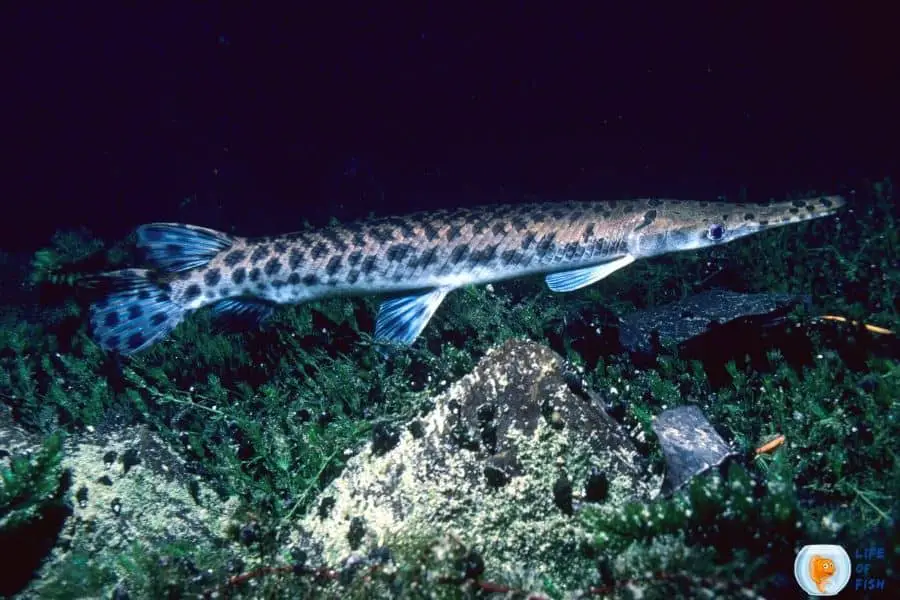
Florida gar is a medium-sized gar species native to Florida. It grows up to 52 inches (4.3 feet) and can only be seen in the Savannah River, Ochlockonee River, peninsular Florida, and Georgia watersheds.
Appearance
The Florida gar can be distinguished from other closely related species by its olive-brown body color. Its dorsal fin is faint and lighter.
The anal fin is also lighter in color, which makes it appear that the tail is bicolored. Both fins are located near the caudal fin, and their body is covered with irregular, round black spots that are bigger than their scales.
The snout is long and narrow, just like an Alligator gar. However, the Florida gar has a smooth and non-serrated teeth margin.
Habitats
These fish usually inhabits medium to large lowland streams, swamps, rivers, and lakes of Florida.
They prefer aquatic habitats with submerged logs and vegetation. You can often find them in medium to shallow waters.
What they eat
Florida gar feeds on small fish, shrimps, crayfish, and crabs. Like their relatives,they also are ambush predators who wait patiently in the shallow waters until a fish swims directly in front of them.
Read More : Florida Gar | 12 Interesting Facts About Florida River Monster |
Longnose Gar
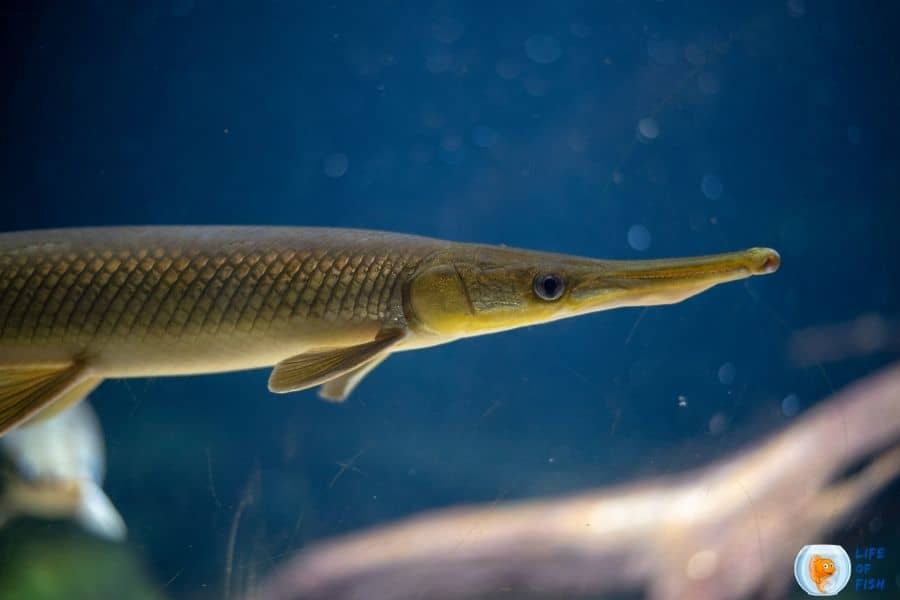
Longnose Gar (lepisosteus osseus), also known as longnose garpike or billy gar, is a gar species native to North America.
You can find this fish in Central America, North America, Cuba, and the Isla de la Juventud. These fish typically grow for about28 to 48 inches but, some specimens reach as long as 6 feet (1.8m).
Like any other gar species, longnose gars are also declining due to habitat loss, overfishing, construction of roads and dams, water pollution, and many other reasons caused by humans.
However, they still have a stable population and are not considered an endangered species.
Appearance
Longnose Gar can be distinguished from other closely related gar species by having a long and slender snout that is longer than its head.
They have a long row of needle-sharp teeth that are shaped like blades. Their dorsal fin is located near the tail, similar to other gar species.
Their body is covered with irregular black spots that are bigger than their scales.
Habitats
Longnose gars mainly inhabit slow-moving and still waters of rivers, ponds, lakes, and swamps.
They live in various habitats, from clear rivers to muddy ponds with large amounts of aquatic vegetation.
They prefer shallow waters that are difficult to spot, making them more likely to ambush their prey.
What they eat
As with most gar species, longnose gars mainly feed on fish, crustaceans, and mollusks.
Longnose Gar feeds by throwing open its jaws to catch small, surface swimming prey like shrimps, fish, and crabs.
It also uses its long pointed nose to sense the prey’s presence in mud or sunlit shallows. This fish also feeds on shellfish and amphibians, and small mammals like rats, mice, and muskrats.
Shortnose Gar
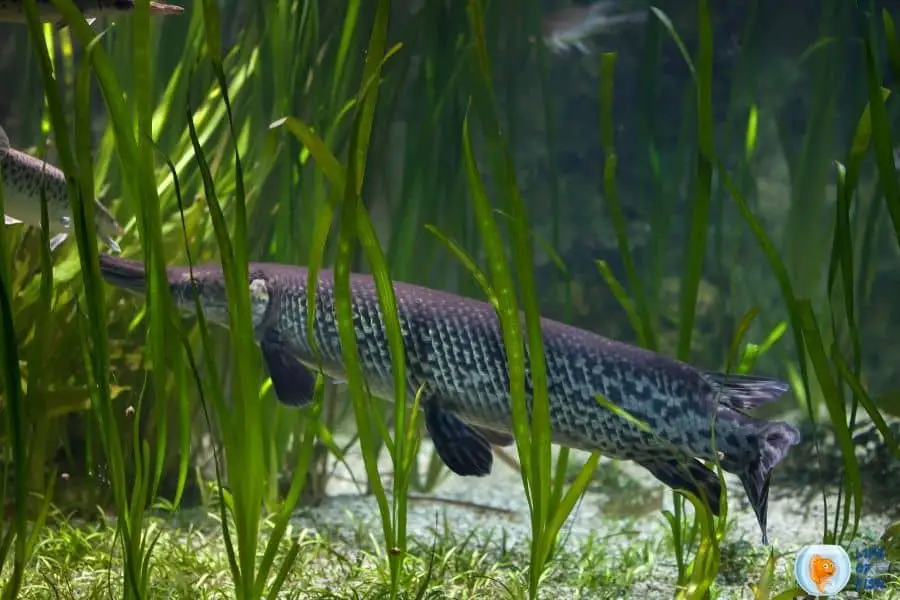
Shortnose Gar is the smallest member of the gar family.
Growing at 35 inches, these fish are distributed throughout the Mississippi and Missouri River basins, from Montana in the west to the Ohio River in the east in the north and from Louisiana and Alabama to sections of Texas in the south.
Because of their small size, Shortnose gars are popular in the aquarium trade as pet fish.
Despite their small size, these fish have very few predators because most predators can not cope with their thick ganoid scale armor.
However, these fish are considered endangered because of their limited population and range.
Appearance
Shortnose Gar can be easily distinguished by its short snout. Also, these fish lack the upper jaw of the Alligator gar.
Shortnose Gar’s dorsal fin is located far behind their head which is located near their tail.
The anal fin is located right below the dorsal fin, and the caudal fin near them is larger than both the dorsal fin and the anal fin.
Shortnose Gar also lacks the spots of Spotted Gar and has only one row of teeth. Other than that, they also have an elongated, torpedo-shaped body with conical teeth.
The color is the same as Alligator gar; olive-brown with a white underbelly.
Habitats
These fish inhabits calm waters of lakes, ponds, rivers, and canals. They prefer slow-moving waters with mud or sand bottom, organic debris, and plenty of aquatic vegetation.
Though these fish are small, they prefer deep water less than 6 feet where they can hide from large predators.
What they eat
Shortnose Gar feeds on the same prey as Alligator gar, including crayfish and amphibians. However, they feed more on insects and crustaceans.
They primarily feed on fish, frogs, and crayfish. They also eat some mollusks, birds, and small mammals.
Spotted Gar
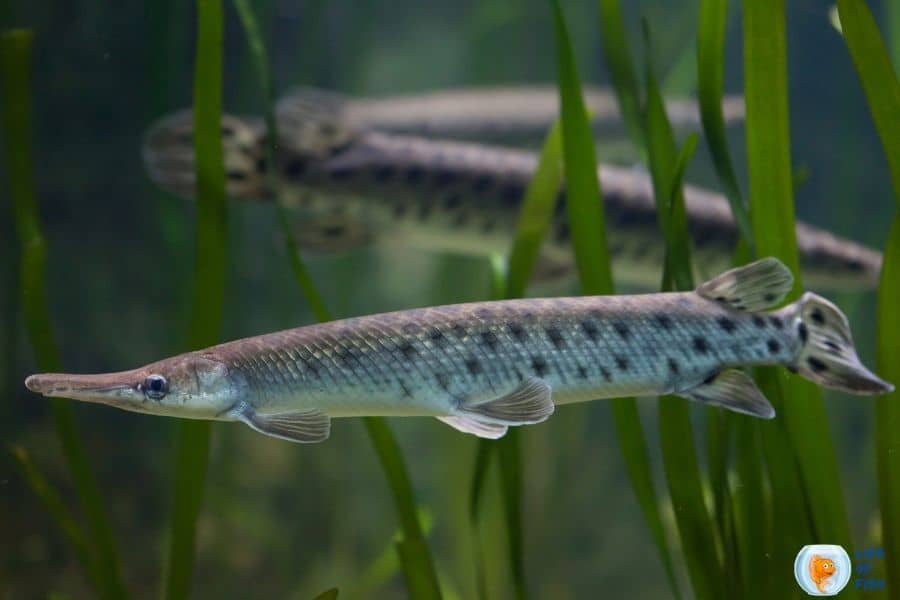
Spotted Gar is closely related to alligator gar. However, they are smaller compared to their long-snouted cousin.
Spotted Gar is distributed in the southeastern United States. Historically, these fish resided in the Thames and Sydenham Rivers in Ontario, Canada, but now they are extirpated.
They can be commonly found from southern Minnesota to Alabama and western Florida in the Mississippi River basin.
Unlike many other gar species, these fish remain on the smaller size, growing up to 2 to 3 feet in length.
These fish are considered to have high levels of Mercury, hence are not consumed as food. Habitat changes and deteriorating water quality are the main threats to Spotted Gar.
Appearance
The spotted Gar has a long, slender body that is covered with black spots. These fish have very sharp teeth arranged in a single row on the upper jaw, roof of the mouth, and vomer.
The anal fin has 5 to 7 relatively short spines with an additional soft ray. The body of spotted Gar is compact, and it has a shorter snout.
The dorsal fin is located near the tail, right behind the anal fins. Spotted Gar has an olive-brown color with dark black spots along its body, head, and fins.
Habitats
Spotted Gar prefers lakes and pools with slow-moving waters and soft bottoms. They can be common in brackish waters of Gulf Coast rivers and swamps.
They usually stay in the shallow water during early summer and move to deeper places when winter approaches.
These fish prefer temperatures from 70 to 79 degrees Fahrenheit. They prefer water with rocks and vegetation.
These fish share habitats with Alligator gar, hence often becoming the prey of Alligator gars.
What they eat
Adult Spotted gars feed on insects, crustaceans, and other fish. Young spotted gar feed primarily on insects.
These fish are mainly piscivorous, and they feed on small fish such as golden topminnow, bluegill, warmouth, and spotted sunfish.
Tropical Gar
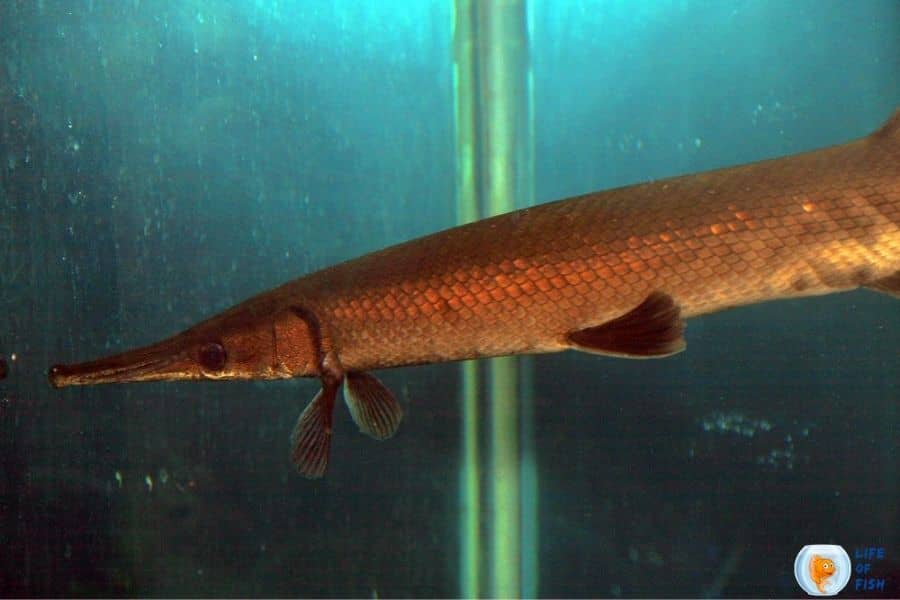
Tropical Gar is the remaining gar species on the list. Unlike other gar species that inhabit North American waters, these fish inhabits the brackish waters of Central America.
These fish are commonly known as pejelagarto in Mexico, with the meaning of “fish alligator” in Mexican.
These fish are widely distributed in their habitats and are not endangered. Their flesh is considered poisonous.
Therefore they are not consumed as food. These fish are medium-sized and reach about 4 feet in length.
Appearance
The body shape of Tropical Gar is overall torpedo-shaped but curved toward the belly.
Like other gar species, Tropical Gar also has an elongated snout, but it is shorter and broader than other gar species.
The dorsal fin and the anal fin are a bit longer but like in other gar species. They are located toward the caudal fin.
The body is silvery color with a dark irregular spot all over the body. Anal fin, dorsal fin and the caudal fin are darker in color. Juvenile specimens are light brownish in color.
Habitats
These fish inhabits both freshwater and brackish water. They can be found in swamps, bayous, coastal brackish and rivers, floodplains, pools, lakes, and lagoons.
Tropical Gar usually lives in water with a salinity of around 12 to 30 parts per thousand. They do not prefer swiftly-flowing waters.
They are commonly found in the Caribbean and Pacific drainages of Central America and southern Mexico.
What they eat
Tropical gars feed on fishes, crustaceans, and frogs. The diet of the tropical Gar comprises almost entirely of cichlids and other fish.
Their teeth are sharp, and they lunge at the prey to get a hold of them. Their diet is generally similar to that of other gar species.
Comparison Table
| Gar species | Alligator Gar | Cuban Gar | Florida Gar | Longnose Gar | Shortnose Gar | Spotted Gar | Tropical Gar |
| Scientific name | Atractosteus spatula | Atractosteus tristoechus | Lepisosteus platyrhincus | Lepisosteus osseus | L. platostomus | L. oculatus | Atractosteus tropicus |
| Habitats | swamps, large rivers, brackish water estuaries, and reservoirs | rivers, lakes, and swamps | medium to large lowland streams, swamps, rivers, and lakes | slow-moving and still waters of rivers, ponds, lakes, and swamps | calm waters of lakes, ponds, rivers, and canals | lakes and pools with slow-moving waters and soft bottoms | swamps, bayous, and coastal brackish and rivers, floodplains, pools, lakes, and lagoons |
| Distribution | USA’s Gulf Coastal states, including Texas, Louisiana, Mississippi, Alabama | Western Cuba the Isla de la Juventud | Savannah River, Ochlockonee River, peninsular Florida, and in watersheds of Georgia | Central America, North America, Cuba, and the Isla de la Juventud | Mississippi and Missouri River basins, Louisiana, Alabama, and Texas | the southeastern United States | Central America |
| Size | 10 feet | 6.6 feet | 4.3 feet | 6 feet | 2.9 feet | 3 feet | 4 feet |
| Color | Olive-brown | grey | Olive-brown with black spots | Brown to olive to green with irregular black spots | Olive-brown | Olive-brown with dark spots | silvery color with dark irregular spots all over the body |
| Life span | 50 years | 18 years | Unknown | 20 years | 20 years | 18 years | 25 years |
| Preferred Food | Fish, birds, small mammals, crayfish, and crustaceans | fish, birds, and shrimps | small fish, shrimps, crayfish, and crabs | crustaceans, and mollusks | Fish, birds, crayfish, and amphibians | insects, crustaceans, and other fish | fishes, crustaceans, and frogs |
Related Questions
What is a hybrid gar?
A hybrid gar is the offspring of a longnose gar and an alligator gar. These fish are rarely found or bred in aquariums. A hybrid gar can reach over 6 feet and over 100 pounds on average.
How long does Gar live?
Gars can live for over 50 years, and their maximum age is about 90 years. The largest gar species,
Alligator gar, had a documented lifespan of 95 years. Smaller gar species like shortnose Gar have a short lifespan of about 20 years maximum.
Is alligator gar a hybrid?
Alligator gar is not a hybrid. But there are rare cases of Alligator gars that hybridized with longnose gars.
Experts consider hybridization between two gar species as rare and often captive-bred only.
Can alligator gar walk on land?
Alligator gars surprisingly can walk on land to some extent. Their large body combined with strong pectoral fins allows them to drag their body on the ground.
They can also jump over the land like a crocodile but only for a short distance.
Conclusion
This article is meant to cover all the types of gar fish found in The United States, focusing on six gar species that are most commonly found in North America.
Gars are ancient fish with spiny scales, and they are among the oldest fish species on Earth.
Gars are feared because of their sharp teeth and colossal size. Although these fish are often aggressive, they are not dangerous to humans unless provoked.
We hope that this article will make the gar species less feared and help people get to know them better.
Read Next : Gold Nugget Pleco Care | 12 Golden Facts Just For You |
